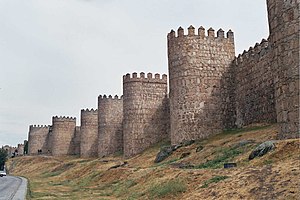Ávila
This article is about the Spanish city. For other uses, see Avila
Ávila
Ávila de los Caballeros, Ávila del Rey, Ávila de los leales | |
|---|---|
Ávila with its famous city walls, as seen from a distance | |
| Motto(s): | |
| Location Location | |
| Country | Spain |
| Autonomous Community | Castilla y León |
| Province | Ávila |
| Government | |
| • Mayor | Miguel Ángel García Nieto (PP) |
| Area | |
| • Land | 231.9 km2 (89.5 sq mi) |
| Elevation | 1,182 m (3,665 ft) |
| Population (2005) | |
| • Total | 53,272 |
| • Density | 226.87/km2 (587.6/sq mi) |
| Time zone | UTC+1 (CET) |
| • Summer (DST) | UTC+2 (CEST) |
| Postal code | 05001 - 05005 |
| Area code | 34 (Spain) + 92 (Ávila) |
| Website | http://www.avila.es Template:Es icon |
| UNESCO World Heritage Site | |
|---|---|
 | |
| Criteria | Cultural: iii, iv |
| Reference | 348 |
| Inscription | 1985 (9th Session) |
Ávila de los Caballeros (Latin: Abila and Óbila) is the capital of the province of the same name, now part of the autonomous community of Castile and León, Spain (see map).
Geography
The city is 1117 meters (3665 feet) above sea level, the highest provincial capital in Spain. It is built on the flat summit of a rocky hill, which rises abruptly in the midst of a veritable wilderness: a brown, arid, treeless table-land, strewn with immense grey boulders, and shut in by lofty mountains. This results in an extreme climate, with very hard and long winters, and short summers.
History

Ávila is most known for the medieval city walls [1], that were constructed of brown granite in 1090: surmounted by a breastwork, with eighty-eight towers and nine gateways, they are still in excellent repair, but a large part of the city lies beyond their perimeter. The Gothic cathedral is integrated into the city's defences. It was built between the 12th and 14th centuries, and has the appearance of a fortress, with embattled walls and two solid towers. It contains many interesting sculptures and paintings, besides one especially fine silver pyx, the work of Juán de Arfe, dating from 1571.

The churches of San Vicente, San Pedro and San Segundo are, in their main features, Romanesque of the 12th century. In the Gothic Monastery of Santo Tomás, erected by the Catholic Queen Isabella in 1482, is especially noteworthy the marble monument, carved by the 15th-century Florentine sculptor Domenico Fancelli, over the tomb of Prince John, the only son of Ferdinand and Isabella.
Famous residents
Ávila was the birthplace of the 4th-century theologian Priscillian, the first Christian to be executed for heresy. The town is more renowned for St. Teresa of Ávila, the Carmelite reformer who lived there twelve centuries later (c. 1515-1582). A convent and church mark the supposed birthplace of Santa Teresa, but she was born in Gotarrendura in the Ávila province. Other prominent natives include Saint John of the Cross, Tomás Luis de Victoria and the Spanish-born American philosopher George Santayana. From 1482 to 1807 it was also the seat of a university.
Food
Typical food in Ávila includes roast lamb, suckling pig, and veal steak. Ávila is also famous for its yemas de Santa Teresa - egg yolk candies named after the patron saint.
References
External links
- Avila's City Hall
- Convent of St. Teresa, Avila
- Photos of Avila
- Satellite picture by Google Maps
- Hazlitt, Classical Gazetteer "Abila"
- Citizens' association for the defence of heritage of Avila - Photos of Avila
40°39′N 4°42′W / 40.650°N 4.700°W
- This article incorporates text from a publication now in the public domain: Chisholm, Hugh, ed. (1911). Encyclopædia Britannica (11th ed.). Cambridge University Press.
{{cite encyclopedia}}: Missing or empty|title=(help)



